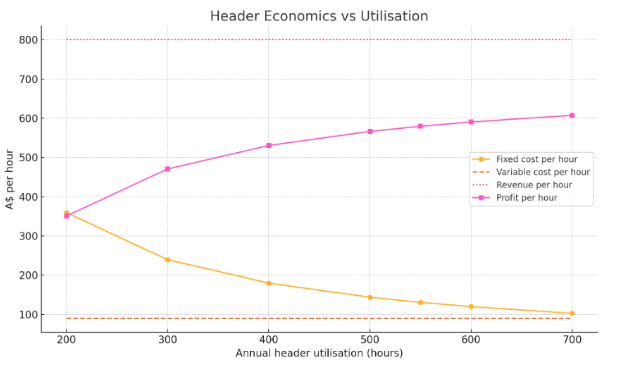
26th July 2025
Ag Contractors Boost Revenue with More Harvest Jobs
TL/DR Running a header in NSW/QLD now costs about A$275 per hour at 500 hours/year, but only ~A$258 per hour at 550 hours – High combine hire rates mean each extra job can add strong profits. Here's how to hit that higher utilisation target and keep more margin in your pocket.
Agricultural Contractors: How Adding More Harvest Jobs Can Boost Your Revenue
Agricultural contractors who own heavy farm machinery like combine harvesters face high operating costs. Many farm contractors in NSW and QLD invest in expensive equipment for the wheat harvest season but only use it for a limited number of jobs. In this blog, we’ll explore why taking on more harvest jobs can significantly increase a contractor’s revenue. We’ll look at the costs of running headers, how doing more work lowers your cost per job, and how tools like AgPages can help farm contractors find and manage additional work. Key topics include agri contractors’ costs, job tracking, and the wheat harvest in Australia.
The Cost Challenge for Farm Contractors
Owning and operating a modern harvester is costly. The upfront price of a combine harvester alone can run into the hundreds of thousands of dollars. For example, a late-model John Deere S790 combine has been listed at around A$750,000–$800,000 used in Australia[1]. New high-capacity harvesters can approach or exceed A$1 million in value[1]. Along with the purchase price come financing costs (interest on loans), insurance, and depreciation. In one NSW Department of Primary Industries analysis from 2012, a combine that cost about A$360,000 new had an annual depreciation of ~$44,900 and interest costs of ~$26,960 at a 10% interest rate[2]. These overhead costs exist no matter how many hours you use the machine each season – they’re essentially fixed yearly expenses. While these numbers have changed, the concept remains.
Variable running costs are significant too. Fuel, maintenance, and repairs add up for each hour the machine operates. Diesel fuel prices have risen in recent years – averaging around A$1.84 per liter retail in Australia[3] – meaning an hour of harvesting (burning ~35–40 liters of diesel) can easily incur $60–$70 in fuel alone. Add engine oil, filters, tyres, and routine repairs, and you might spend another ~$20–$30 per hour on maintenance and parts. All told, for a typical mid-size combine in 2025, the total header running cost might be on the order of $300+ per hour of operation when accounting for both fixed (overhead) and variable costs. This is based on current equipment prices and fuel rates, up sharply from roughly $205/hour in 2012 estimates[4].
Spreading Costs: Why More Hours Lower Your Cost per Job
Fixed ownership costs (depreciation, insurance, registration, loan interest, etc.) are incurred annually regardless of usage. By increasing the number of hours or jobs you do in a year, you spread those fixed costs over more work, reducing the cost per hour for each job. A NSW DPI cost guide demonstrated this effect clearly: using the same header for 500 hours/year versus only 400 hours pushed the cost per hour down from about $243 to $206, and increasing utilisation to 550 hours/year dropped it further to around $192/hour[4].
To illustrate, consider a contract harvester charging around $800 per hour (a rate in line with industry recommendations for a Class 7–8 combine[5], with fuel usually supplied by the farmer). If your own cost to operate is say ~$250/hour at low utilisation, you’d net about $550/hour profit at that rate. But if you only get 200–300 hours of work in the season, that profit might barely offset your annual overhead. Now, if you double your workload to ~600 hours by taking on more jobs, your cost per hour could drop to ~$180–$200 as fixed costs are spread out. You would then net closer to $600+ per hour.
Chart: Header Economics across operating hours

(A simple chart illustrating the change in fixed costs, revenue and margins by spreading costs over more work.)
Maximizing the Wheat Harvest Window in NSW and QLD
One practical way to add more jobs is to extend your working season by covering a wider region. In Australia, the wheat harvest progresses from north to south across the eastern states. For instance, parts of Queensland begin harvesting as early as September, while southern New South Wales and Victoria continue into December. Some savvy contractors “follow the harvest” – they might start with jobs in central or northern Queensland and then move down through NSW as later crops ripen[6].
Land More Jobs and Track Them with AgPages
AgPages is a purpose-built job matching platform that connects farmers with skilled contractors in Australia. It’s focused on the wheat harvest season in NSW and QLD, making it highly relevant for local contractors. It delivers job leads directly to you – farmers post harvest jobs and you get notified of opportunities that match your services and region[7].
The platform emphasizes saving time by letting you manage everything in one place: job details, schedules, quotes, invoices – all through a dashboard[8]. AgPages also provides benchmark pricing data[9] and lets contractors build reputation via verified reviews.
Conclusion: More Jobs, More Revenue – Work Smarter This Harvest
Platforms like AgPages allow farm contractors to find additional work without the traditional legwork, and to manage those jobs professionally through a central system. If you’re looking to grow your contracting business, consider tapping into such services to fill your calendar. More jobs not only increase your gross revenue but also improve your cost efficiency and profit margins.
FAQ
How much should ag contractors charge per header hour in 2025?
Industry guidelines in Australia suggest that contract harvesting rates for a modern combine harvester are about A$680–$950 per hour (GST exclusive, fuel supplied by the farmer) depending on the machine’s class[5]. For example, a Class 7 or 8 header can typically command around $780–$850/hour, so charging roughly $800/hour is common[5]. This rate is designed to cover the contractor’s costs (labor, fuel, maintenance, insurance, etc.) and provide a margin. Each contractor should adjust their rate based on their exact costs and local demand, but it’s important to charge enough to cover rising expenses like fuel and to account for the machine’s depreciation and finance costs. Check out the free calculator available on AgPages.
What is the hourly running cost of a combine harvester?
The operating cost of a combine harvester in Australia can be in the ballpark of A$250–$300 per hour in 2025 for a mid-size machine under typical conditions. This includes fixed ownership costs (depreciation, financing interest, insurance, registration) plus variable costs (fuel, oil, filters, tyres, repairs). For perspective, a NSW DPI analysis in 2012 estimated about A$205 per hour total cost for a header used 500 hours/year[4]. Costs have increased since then due to higher diesel prices (around $1.84/L now[3] vs ~$0.96/L in 2012) and higher machinery prices. At current fuel prices and equipment values, many contractors figure on something near $300/hour all-in for a combine’s running costs. The exact figure for your operation will depend on your machine’s value and age, your maintenance practices, and how many hours you work (higher utilisation will bring the per-hour cost down).
How can farm contractors get more harvest jobs?
Farm contractors can find more harvest jobs by expanding their service area and leveraging networks or platforms. One approach is to “follow the harvest” seasonally – for example, start harvesting in Queensland (which has an earlier harvest) and then move down to New South Wales and even Victoria as the season progresses[10]. This allows you to extend your working season beyond just your local harvest window. Additionally, using dedicated job marketplaces like AgPages can connect contractors to farmers seeking help. AgPages matches farmers and contractors and sends you leads for jobs in your chosen regions[7], so you don’t have to rely only on word of mouth. By building a strong profile on such platforms and maintaining a good reputation, you can land more contracts. In short, to get more harvest jobs: be willing to travel to where the work is (north to south), and take advantage of online tools that match you with farmers in need of contract harvesting. This will keep your calendar full and your header working at profitable levels.
Author:

Related Articles
AgPages is Live: A Better Way to Connect Farmers and Contractors
Harvest season is fast-paced, high-stakes, and too often – stressful. AgPages has officially launched to help change that.
How to Find and Vet the Best Harvest Contractors: 5 Essential Tips for Farmers
Finding a reliable contract harvester is crucial for a smooth wheat harvest season. Learn how to verify credentials and connect with pre-vetted contractors.
References
- [1] Combine Harvester - New or Used Combine Harvester for sale - Australia
- [2] Guide to tractor & implement costs.xls
- [3] aip.com.au – Diesel Prices Report
- [4] Guide to tractor & implement costs.xls
- [5] Harvest Rates | Australian Custom Harvesters
- [6] Record-Breaking Australian Winter Harvest
- [7] [8] [9]AgPages
- [10] Farm Work Victoria | Agri Labour Australia